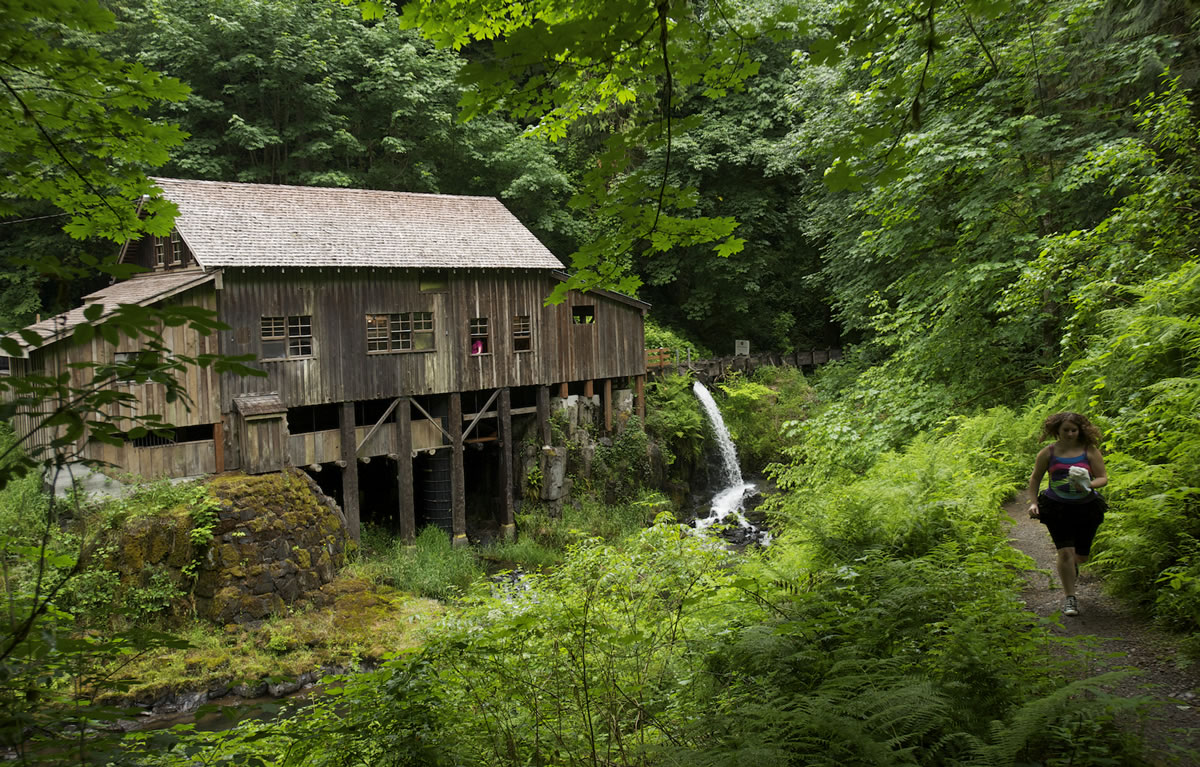The grist mill has special events on the last Saturday of each summer month.
July 28:
Blueberry Pancake Day
Aug. 25: Cornbread and Bluegrass
Sept. 29: Bread and Butter
The mill is available for private tours for groups of at least 10. Call 360-247-7413.
The miller with the white beard nodded to a man across the room, who turned an iron throttle wheel. Bearings, belts, wheels and shafts inside the old mill began to spin.
Reddish grain disappeared into the mouth of an antique apparatus.
The miller cocked his head to listen. He tweaked a wheel on the side of the machine and reached into the stream of white flour pouring out of its bottom.
A young man next to him also tested the powdery product with his hand.
“You’re okay with that?” the miller said.
“Yeah,” the youth said.
The pair, one five decades older than the other, were making bread flour the way it had been made for hundreds of years: whole grain, using water to turn two millstones mounted in a building of wood-pegged timber.
The grist mill has special events on the last Saturday of each summer month.
July 28:
Blueberry Pancake Day
Aug. 25: Cornbread and Bluegrass
Sept. 29: Bread and Butter
The mill is available for private tours for groups of at least 10. Call 360-247-7413.
That building is the Cedar Creek Grist Mill, 10 miles east of Woodland. The 136-year-old mill is preserved and operated by a group of volunteers, nearly all of whom are past retirement age. This summer, they realized a long-hatched plan and hired an intern from Clark College’s baking program, who will receive a scholarship upon completion of his engagement at the mill.
The nonprofit Friends of the Cedar Creek Grist Mill exists to educate people, said Barb Sizemore, a member of the group. The mill can be used to teach lessons about the importance of whole grains, about renewable energy, sustainable building and the importance of grain to the economies of Washington and Oregon.
The group long wanted to pass along these lessons to young people who work with flour and grains. This year, they finally were able to start their internship program.
The exact scholarship amount will be determined by how many donations roll in over the next few months, but will likely be $1,500, Sizemore said. The intern will put in 120 hours on weekends, milling and explaining the process to visitors.
Many variables go into making good flour, said Tom Henrich, the 72-year-old miller.
First is the quality of the grain, of course. The nonprofit buys all its grain from Bob’s Red Mill in Portland. But from there, the process takes an experienced operator.
The pure mechanics of the mill are fairly easy to understand. The grain is milled between two stones that sit in a metal apparatus built around 1850. The stones are separated by a gap as thick as a sheet of paper. A turbine spinning under water pressure below the wooden building turns the stones via a system of belts and flywheels.
Then things get trickier. Different grains are milled at different speeds. Hard red wheat for bread requires a slightly higher speed than corn, said Greg Kehn, whose turn of the throttle wheel determines the speed.
And the gap between the stones needs to be set just so to get the right texture of flour, said Henrich.
“I watch how the grain is flowing and listen to the sound of the mill,” he said.
By December, Charles Fallihee hopes to have acquired an ear for the mill.
The 21-year-old student from Gresham, Ore., spent the last three weekends at the grist mill, learning its past and present. His instructor at Clark College’s baking program suggested him for the internship, Fallihee said.
The young man got his start in the culinary arts by helping out in Portland kitchens. He quickly realized his mentality was better suited to baking than cooking.
“They say baking is a science and cooking is an art,” he said.
He prefers the scientific approach.
Student of flour
At the same time, he’s enamored of the low-tech fabrication of flour in the mill.
Commercial flour has the essential oils from the grain’s germ stripped out of it, said Henrich, the miller. The oils drastically shorten the flour’s shelf life to about one month without refrigeration. But they also contain nearly all the nutritious components of the grain, such as proteins.
And using whole grain does not mean sacrificing flavor for nutrition.
Out on the porch on Saturday, Sizemore laid out cookies, muffins, shortbread and scones made from flour milled in the old way. One plate held small, moist blueberry muffins Fallihee made with a recipe from his bakery program.
They were delicious.
Jacques Von Lunen: 360-735-4515; http://twitter.com/col_schools; jacques.vonlunen@columbian.com.



